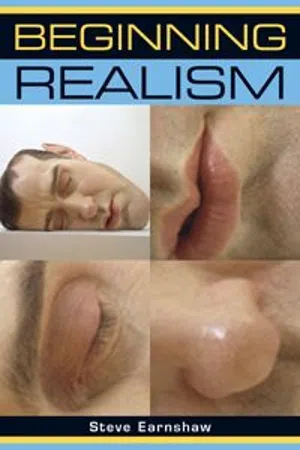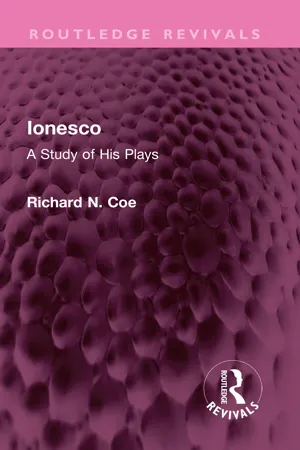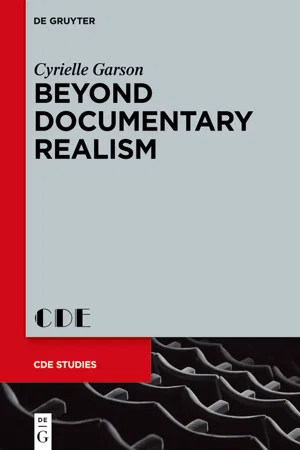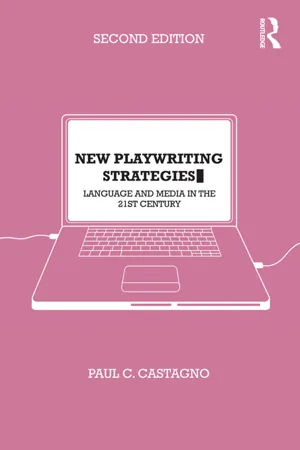Literature
Theatrical Realism
Theatrical realism is a style of theatre that aims to create a lifelike representation of everyday life on stage. It emphasizes naturalistic acting, settings, and dialogue to reflect the real world. This movement, which emerged in the late 19th century, sought to bring a sense of authenticity and truth to theatrical performances.
Written by Perlego with AI-assistance
Related key terms
7 Key excerpts on "Theatrical Realism"
- eBook - ePub
- G. R. Thompson(Author)
- 2011(Publication Date)
- Wiley-Blackwell(Publisher)
Chapter 2 Of Realism and Reality Definitions and ContextsAs a literary term, realism normally refers to a theory and practice of fiction in which the artistic goal is to portray “life as it is” – rather than intensified or as it should be – and in simple direct language rather than striving for striking metaphors and indulging in rhetorical flourishes. The elevated subject matter of classic tragedy, or the poetic elements of optative romanticism, or the sentimental aspects of domestic novels and romances, or the hair-raising events of gothic romances were to be downplayed or avoided in favor of the everyday, average, prosaic aspects of life.Realism in this sense was especially prominent in France, England, the United States, and Russia from about the mid-nineteenth century to the 1930s and 1940s (and beyond). But there are realistic, mimetic elements in works written centuries before: in the Iliad and the Odyssey (c. eighth century bc), in the plays of Sophocles (496–406 BC), in Boccaccio's Decameron tales (1351–1353) and Chaucer's Canterbury Tales (c. 1387–1400), in the plays of Shakespeare (1564–1616) and other Renaissance dramatists. Don Quixote (Part I, 1605; Part II, 1615) presents a hybrid form of a romance and novel in which the interplay of worldviews is centrally informed by the mixture of realism with idealized romanticism. Many consider this seventeenth-century work the cornerstone of the modern novel.In the English-speaking world, literary historians generally point to the principal eighteenth-century British novelists as anticipating the nineteenth century in the development of modern realism. In American literature, the primary meaning of realism indicates a period: the historical era from about a decade after the American Civil War to a decade or two after World War I.1 But literary realism, even when confined to a historical period, is not a single undiversified idea or theoretical program or movement. In both Britain and America, major fictional forms partaking of both realism and romance included the domestic novel , the novel of manners , and the sentimental novel . In America there was an important, predominantly realist, movement toward regionalism , within which broad rubric a form called local color is sometimes distinguished. Both centrally involve a forceful vernacular style (idiomatic spoken language), often in dialect (regional or ethnic idiom). In addition, we can identify, at the minimum, several forms of realist theory and practice in Europe and America: objective realism , compassionate realism , benevolent realism , and sentimental realism . There is also a distinction to be made between intense “social reformist” realism and “quiet” realism. Variations on realism and anti-romance are also in tension with, or in complementary relation to, impressionism and expressionism and most especially naturalism .2 - eBook - ePub
- Steven Earnshaw(Author)
- 2013(Publication Date)
- Manchester University Press(Publisher)
Germinal . Inner thoughts are difficult to render naturalistically (see later discussions in the chapter of ‘the aside’, for instance). If the roots of the novel are in history writing, biography, autobiography, letter-writing, social observation and surveys, moral conduct books and journalism, there is a certain congeniality in these forms for the purposes of the Realist aesthetic, and discussion of the novel genre has focused on how central realism is to its essence. Analogous discussion about the idea of drama has often focused on precisely what ‘drama’ means, and just as ‘poetry’ is by definition opposed to ‘prose’, so ‘drama’ – the dramatic – appears inherently opposed to what is ‘everyday’, mundane and dull. To move into the twentieth century before returning to the specifics of the Realist period, two pieces separated by nearly 80 years argue for the essentially ‘dramatic’ nature of drama. Meyerhold’s piece ‘On the Theatre: The Fairground Booth’ claims that the theatre had become dominated by realism, and argues instead that theatre is defined by what is anti-naturalistic:The public comes to the theatre to see the art of man, but what art is there in walking about the stage as oneself? The public expects invention, play-acting and skill. But what it gets is either life or a slavish imitation of life. Surely the art of man on the stage consists in shedding all traces of environment, carefully choosing a mask, donning a decorative costume, and showing off one’s brilliant tricks to the public – now as a dancer, now as the intrigant in some masquerade, now as the fool of old Italian comedy, now as a juggler. (in Brandt 1998: 132–3)Howard Barker’s ‘Theatre without a Conscience’ in 1990 makes a similar point: theatre is precisely what is not in the world outside the auditorium. He argues that if it does draw from the real world in the manner of journalism and academic research then it is not theatre at all. At the heart of drama, then, runs a strong argument that in essence it is non-realist or anti-realist. And while the relative successes of Realist novels might be debated, there is little argument that the Realist novel has the means of being Realist within the theoretical tenets of that aesthetic. - eBook - ePub
Ionesco
A Study of His Plays
- Richard Coe(Author)
- 2023(Publication Date)
- Routledge(Publisher)
The New TheatreA ‘realistic theatre’, to all intents and purposes, is a contradiction in terms. The drama is an artistic medium which of necessity is governed by its own laws, and in no case are the laws which determine a form of art identical with those which control the raw material of ‘real’ life. The moment an experience is transferred from life to the stage, it undergoes a radical transformation, and such lingering elements of ‘realism’ as it may retain are nothing but the product of a skilful illusion. More than anything else, it is the realisation of this fact that characterises the avant-garde theatre of the twentieth century. The whole art of the theatre is precisely the art of illusion; but to limit the scope and blunt the purpose of this imaginative vision, to restrict it and to curtail it, so that in the end it dare attempt nothing save the photographic reproduction of a specific and small part of the raw material (human ‘reality’) amidst which it was primitively conceived, is ‘absurd’ – a monstrous waste of time and energy, a frittering-away of vital resources, worse (in Ionesco’s words), a ‘distortion’, a ‘shabby piece of trickery’,1 by which an audience is cheated into believing that there is no ‘reality’, save what may be equated with ‘realism’.It was as a by-product of eighteenth-century scientific rationalism that the theory of a realistic drama gradually emerged; and conversely, as soon as rationalism began to lose its hold upon the imaginative consciousness of Europe, so creative artists in every field began to cast around for means of expression which should transcend the narrow bounds of naturalistic representation. But of all art forms, the theatre has proved the slowest to adapt itself to such a sweeping revolution – necessarily so, since its audience is the mass; and whereas a painter can sell his work and live, if he find but one connoisseur both sensitive and wealthy enough to appreciate him, the dramatist must count his converts by the thousand before he (and his dependent actors) can hope to earn a living. And so, more than half a century after the protests of Strindberg and Claudel and Jarry, the ‘naturalistic’ theatre still lingers on in every capital in Europe: in Moscow, haltingly supported by the doctrine of ‘socialist realism’ and the memory of Gorky; on Shaftesbury Avenue (and on Broadway), carefully tended by considerations of box-office; in Paris, reviled and despised by every critic of repute as ‘théâtre de boulevard’, fit only for shop-girls, concierges - eBook - ePub
Beyond Documentary Realism
Aesthetic Transgressions in British Verbatim Theatre
- Cyrielle Garson(Author)
- 2021(Publication Date)
- De Gruyter(Publisher)
theatrical representation” (152). In other words, realism is created through the turbulent movements of signs framing a typical verbatim production and its relationship with the world outside the theatre. Such relationships are more intense than in realist fictional plays and programme audiences for interesting new habits and practices. 34 Actress Bella Merlin offers an animated account of this curious phenomenon in the context of a discussion she had with playwright David Edgar (after a performance of David Hare’s The Permanent Way) who remained tied to an earlier claim according to which “documentary drama relies on its facts being correct” (Farce 54): the playwright David Edgar who came to see it […] said to me, ‘Gosh, isn’t it fascinating that a woman was involved in this privatisation of the railways?’ And I went, ‘Oh, no, it’s not a woman in real life, it’s a man.’ And he went, ‘You can’t do that in a verbatim drama. If you’re gonna put a woman on stage you gotta know that it was a woman who did it’. (“Bella” 8) What this highlights is symptomatic of a category of theatrical reality that is expanded to the field of non-theatrical reality. Put more productively as regards to films, William Guynn argues that there is a fundamental difference between fictional films and non-fictional ones as the latter succeed “in producing in the spectator a specific sense of the real, which we must distinguish from the impression of reality experienced by the spectator of the fictional film” (40) - eBook - ePub
- Raymond Williams(Author)
- 2013(Publication Date)
- Parthian Books(Publisher)
7 Realism and the Contemporary NovelThe centenary of ‘realism’ as an English critical term occurred but was not celebrated in 1956. Its history, in this hundred years, has been so vast, so complicated and so bitter that any celebration would in fact have turned into a brawl. Yet realism is not an object, to be identified, pinned down and appropriated. It is, rather, a way of describing certain methods and attitudes, and the descriptions, quite naturally, have varied, in the ordinary exchange and development of experience. Recently, I have been reconsidering these descriptions, as a possible way of defining and generalising certain personal observations on the methods and substance of contemporary fiction. I now propose to set down: first, the existing variations in ‘realism’ as a descriptive term; second, my own view of the ways in which the modern novel has developed; third, a possible new meaning of realism.There has, from the beginning, been a simple technical use of ‘realism’, to describe the precision and vividness of a rendering in art of some observed detail. In fact, as we shall see, this apparently simple use involves all the later complexities, but it seemed, initially, sufficiently accurate to distinguish one technique from others: realism as opposed to idealisation or caricature. But, also from the beginning, this technical sense was flanked by a reference to content: certain kinds of subject were seen as realism, again by contrast with different kinds. The most ordinary definition was in terms of an ordinary, contemporary, everyday reality, as opposed to traditionally heroic, romantic or legendary subjects. In the period since the Renaissance, the advocacy and support of this ‘ordinary, everyday, contemporary reality’ have been normally associated with the rising middle class, the bourgeoisie. Such material was called ‘domestic’ and ‘bourgeois’ before it was called ‘realistic’, and the connexions are clear. In literature the domestic drama and, above all, the novel, both developing in early eighteenth-century England with the rise of an independent middle class, have been the main vehicles of this new consciousness. Yet, when the ‘realist’ description arrived, a further development was taking place, both in content and in attitudes to it. A common adjective used with ‘realism’ was ‘startling’, and, within the mainstream of ‘ordinary, contemporary, everyday reality’ a particular current of attention to the unpleasant, the exposed, the sordid could be distinguished. Realism thus appeared as in part a revolt against the ordinary bourgeois view of the world; the realists were making a further selection of ordinary material which the majority of bourgeois artists preferred to ignore. Thus ‘realism’, as a watchword, passed over to the progressive and revolutionary movements. - eBook - ePub
Towards Good Lighting for the Stage
Aesthetic Theory for Theatrical Lighting Design
- Marcus Doshi(Author)
- 2022(Publication Date)
- Routledge(Publisher)
how it is revealing it that the magic lies.Naturalism
Now then, if one is to contend with the idea of realism in the theatre as a production style, one must contend with naturalism as a movement. This is because, at least in my experience, these words are often used interchangeably in conversation with an imperceptible distinction between the two. There is a difference between them, albeit subtle, which I think is important. This difference gives specific meaning to the word “realistic,” a word we encounter over and over in the theatre. Before I dig into this topic, I do want to acknowledge that there are about as many opinions about realism and naturalism, their pros and cons, and their precise origins as there are stars in the sky. So, my opinions on this topic are not orthodox. Rather, they arise from repeated collision with the concepts in production and in the classroom, my own rooting around in the dirt for understanding, and conclusions I have made regarding realism and my own aesthetic.Back to the point at hand: naturalism is a broad term for an early-modern art movement that emerged in the latter half of the 19th century that was, like all art movements, reactionary to its predecessors and fed by the zeitgeist. By the mid-19th century, historical dramas and melodramas, such as the well-made plays of Eugène Scribe, dominated the stages of the self-styled Western world. At the same time, huge advances in the physical and social sciences were pushing the boundaries of humanity's understanding of itself and of the natural world. Christopher Innes, in his introduction to A Sourcebook on Naturalist Theatre, cites Darwin's 1859 On the Origin of Species, Claude Bernard's 1865 Introduction à l’étude de la médicine experimental, Karl Marx's 1867 Das Kapital, and the work of Sigmund Freud, including his 1900 The Interpretation of Dreams, as well as, “… the emergence of materialistic capitalism and the rise of middle-class democracy” as primary influences on naturalism.13 - eBook - ePub
New Playwriting Strategies
Language and Media in the 21st Century
- Paul Castagno(Author)
- 2012(Publication Date)
- Routledge(Publisher)
Poetics still remains the putative criterion for most dramatic forms. Aristotle’s focus on the dramatic rather than the theatrical privileged the literary dimension. Of the six elements, he relegated spectacle to the lowest rung on the hierarchical ladder, below plot, character, thought, diction or language, and music. Indeed, the inclusion of “theatrical” stage directions rendered the literariness of dramatic literature problematic. Historically, for dramatic works to be accepted into the canon, literary values needed to be emphasized while theatricality was diminished in importance. There was an emphasis on character decorum and verisimilitude. Then the advent of psychology and psychoanalysis in the nineteenth century revolutionized notions of the personality. The “inner life” of the character became the focal point. Over time, the parameters of the well-constructed character have been established as a manifestation of these nontheatrical rubrics.However, this trend is undergoing a major shift. The popular pantomimic and comedic traditions of European theater and the physicality drawn from Asian theatrical forms, that have emphasized an external approach to character, are now transforming American dramaturgy. Recent plays, such as Naomi Iizuka’s 36 Views, which interpolates Kabuki theatrics, and Parks’s Topdog/Underdog
Index pages curate the most relevant extracts from our library of academic textbooks. They’ve been created using an in-house natural language model (NLM), each adding context and meaning to key research topics.






